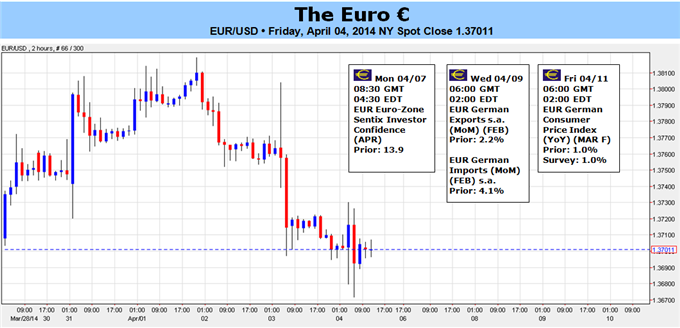
Fundamental Forecast for Euro: Bearish
- The Euro saw its highs early in the week but was generally weaker into the ECB rate decision.
- The ECB rate decision carried a heavy dovish connotation, leading to bearish opportunities in several EUR-crosses.
- Have a bullish (or bearish) bias on the Euro, but don’t know which pair to use? Use a Euro currency basket.
The European Central Bank’s (ECB) patience with the region’s lackluster recovery may be running out, if one is to believe the rhetoric deployed by President Mario Draghi at the April press conference. Although the ECB held its main refinancing rate on hold at 0.25%, a record low, it was clear that the downturn in economic data over the past several weeks, highlighted by the headline March CPI figure coming in at +0.5% y/y, a four-plus year low, and far beneath the ECB’s medium target of +2%.
There were several tweaks in ECB President Mario Draghi’s tone on Thursday that suggested a more dovish consensus is forming among the Governing Council Members. It was made clear that the council voted unanimously to explore the use of unconventional monetary policy measures, even as President Draghi noted that all the conventional tools hadn’t yet been deployed. Negative interest rates and a round of the ECB’s own version of quantitative easing (QE) was discussed.
The implication that the ECB stands ready to act in the face of a deflating price environment and soft economic horizon inherently suggests an air of credibility to the idea that the ECB could implement non-standard accommodative policy measures. In meetings past, any such commentary that implied the desire for a weaker Euro or hope for continued improvement in growth was met with skepticism by the market; the Euro had developed the reputation for bouncing back after the past several meetings, including the November rate cut (an important low for EURUSD formed that day).
Now that it’s been made clear by the ECB that it recognizes jawboning is losing gravitas – threats of action but no such specific action (see: the ECB’s success with bringing down PIIGS sovereign bond yields without having to operate within the scope of the OMT, not even once) – the path forward will require more explicit details of what measures the ECB might take going forward.
In recent weeks, several policymakers have expressed their displeasure with the elevated Euro exchange rate, and it’s of little surprise that a threat of implementing negative deposit rates would be utilized in order to stem speculative inflows into the currency. The other threat, a full blown QE program, saw its first trial balloon float by on Friday, when German media outlet FAZ reported that the ECB had modeled a €1 trillion QE program, with results seeing anywhere from a +0.2% to +0.8% increase in inflation.
For now the table is set for the Euro to fall but several things will need to develop in the coming weeks and months in order for weakness to flourish – and that’s because there is a trade cushion supporting a higher Euro exchange rate. First, as noted by President Draghi, the stress tests (AQR: asset quality review) have resulted in curbed risk taking by Euro-Zone banks; and to avoid creating a panic about the system before the tests in November, the ECB will try to avoid another liquidity injection.
Accordingly, the economic data picture must remain soft for the ECB’s dovish threats to carry any weight insofar as the threat of non-standard policy measures doesn’t seem legitimate in the face of improving growth prospects and elevated price pressures. Neither of those conditions exist presently (Citi Economic Surprise Index hit a fresh yearly low at -9.0 on Thursday, and was at -8.3 at Friday’s close; both headline CPI and PPI readings are at their lowest levels in over four years). With several EUR-crosses showing technical patterns that would indicate lower Euro prices, continued weakness in economic data will be the only fuel needed to weigh down the once-resilient currency. –CV
To receive reports from this analyst, sign up for Christopher’s distribution list.
original source

 By
By 



